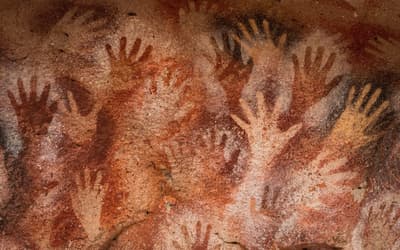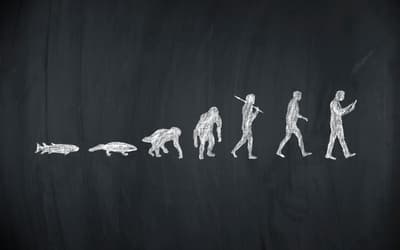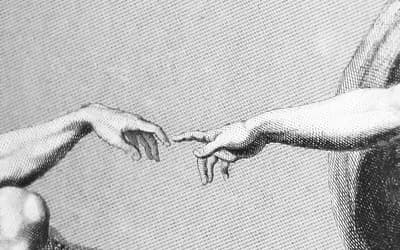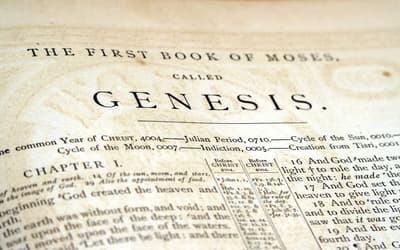The views expressed in this paper are those of the writer(s) and are not necessarily those of the ARJ Editor or Answers in Genesis.
Abstract
The Lost World of Adam and Eve, the latest of the Lost World trilogy, discusses the nature of biblical anthropology in the light of the author’s perception of the true context of ancient Israel. John Walton has attempted to construct this context through his understanding of the ancient Near East (ANE) as the setting for which Israel received the Scriptures. In doing so, he discusses the nature of the first three chapters of Genesis and proposes that the text is giving an account not of material origins, but of the inauguration of creation as God’s cosmic temple in which we find the role of humanity. Within this framework, Walton presents his case for uncovering the history of human origins.
This paper contends that Walton has given a magisterial authority to the ANE mythic texts in order to interpret the Genesis accounts. In doing so, he has relegated Genesis to just another ANE mythical text and inevitably redefined key biblical doctrines regarding material origins to such a degree that infringes on the very nature of orthodoxy. Further to this, his attempt to accommodate modern evolutionary philosophy is unwarranted and unsubstantiated.
Keywords: Lost World, John Walton, Old Testament backgrounds, Ancient Near East, Enuma elish, Atrahasis, functional creation, material creation, cosmic temple
Introduction
The Importance of Old Testament Backgrounds
The study of Old Testament backgrounds has gained increasing prominence in biblical scholarship. The excavations of the libraries from the ancient Near East (ANE) and the decryption of ancient languages have produced many examples of literature revealing great similarities to the biblical accounts such as Creation, the Fall, the Flood, the patriarchs, and the tower of Babel. Further to this literature, archaeological dig sites have uncovered buildings, communities, water systems, and city layouts. They have uncovered artifacts including jewelry, pottery, weaponry, and a host of other helpful keys to constructing a picture of life in ancient cultures. Victor Matthews, specialist in the social world of the ANE, has summarized this idea:
The gulf of thousands of years that separates us from them can be bridged, at least in part, by insights into their everyday life. Such insights can be garnered through close examination of biblical data with written and physical remains from other ancient civilizations. (Matthews 2006, 11)
While this statement would find general agreement in biblical scholarship, there is a wide-ranging application of the archaeological data with respect to biblical hermeneutics. The evidence produced from the mounds of Nineveh and Nippur and other ANE locations is common to all. Even so, major differences in biblical scholarship appear on the basis of one’s interpretation of the common evidence and the level of priority given to Scripture in the process.
Archeology and studies in ANE languages and culture are fields that pose much promise to strengthen the church through an enhanced understanding of biblical backgrounds and use in biblical apologetics. Instead, an increased level of discernment is required from people in the pews who read the works of some scholars who vocally proclaim commitment to biblical authority and inerrancy while giving magisterial authority to ANE material. This contradiction has resulted in doctrinal positions that depart from traditional orthodoxy.
John Walton has produced his work as a trilogy for lay readers. The series of three books, written to be accessible to the wider church, share The Lost World as a common element in their titles, the first of which was The Lost World of Scripture (Walton and Sandy 2013). In this first book Walton discusses ANE culture and biblical authority. “The Lost World” element indicates that it is only upon recent discoveries and study of ANE literature that scholars have been able to reconstruct a true understanding of the context of the Old Testament Scriptures. This context, he proposes, vastly changes the way that the church has traditionally understood Genesis as an account of material origins (its physical origins) (Walton 2009, 21–35). It also means that apostolic references to origins were made without a proper understanding of the ANE context. In light of the ANE literature, Walton now poses that the “author of Genesis” nowhere suggests that the Creation Week is an account of material origins. His theory is that because ancient Israel’s neighbors described the cosmos in terms of the temple of the gods and creation in terms of making that temple function, so too Israel understood the Genesis account as describing functionality in God’s cosmic temple and not as a record of material origins. As this paper will now show, this has major implications upon critical Christian doctrines, such as sin and atonement, which find their foundational history necessary for coherency in the early chapters of Genesis.
Chapter Summaries
In The Lost World of Adam and Eve, Walton presents his case through a series of 21 propositions. Each proposition is a chapter heading. What follows is a brief summary of each of the chapters.
Proposition 1: Genesis is an Ancient Document
Chapter 1 sets the scene for the book with a discussion on context. A careful differentiation is made between high and low context settings. In a high context setting for communication, terms and descriptors do not need to be carefully defined because all communicants are aware of their meaning (Walton and Wright 2015, 16–17). It is suggested that modern readers of Genesis are in a low context setting of communication because we are separated by vast amounts of time, as well as differences in culture, language, and—usually—geography.
Proposition 2: In the Ancient World and the Old Testament, Creating Focuses on Establishing Order by Assigning Roles and Functions
In chapter 2 Walton presents the creation account in Genesis 1 as a description of bringing order to the absence of order rather than a history of material origins. Genesis 1:1 is seen as the summary statement and Genesis 1:2 describes the pre-ordered creation. In other words, Genesis 1:2 marks the beginning of the Creation Week as the process of bringing order to a materially preexisting non-ordered world. This means that the traditional understanding of the Hebrew words for “create” (ברא), “formless” (תהו), “void” (בהו), and “make” (עשׂה) must be redefined from their material context to a functional one (Walton and Wright 2015, 28–31). Walton attempts to do this through a study of the semantic range found in other biblical and extra biblical texts. In light of the ANE texts, to create is to bring order. The description of formlessness is to lack purpose or worth, and combined with being void describes the earth as lacking order and function. He states,
It now becomes clear that the starting condition in Genesis 1:2, the pre-creation situation that describes nonexistence, is a condition that is not lacking material. Rather, it is a situation that is lacking order and purpose. “Formless” is not a good choice because it still implies that material shape is the focus. It is not. This leads us to the conclusion that for Israel, creation resolves the absence of order and not the absence of material. (Walton and Wright 2015, 28)
The pre-creation condition is stated as “negative cosmology” or “denial of existence.” Evidence of such a condition of non-order in a pre-creation context is given from the Enuma Elish,1 the Babylonian creation story. In line with the view that the rest of Genesis 1 is not an account of a material origin, Walton also notes that the image of God in human beings is not a description of the unique creation of mankind but the functions of being God’s representatives for all humanity.
Proposition 3: Genesis 1 Is an Account of Functional Origins, Not Material Origins
How this functionality is explained in the terms of each day of creation is found in chapter 3. Various similarities are proposed between Scripture and ANE literature. The Assyrian king placed his image in conquered territories to proclaim his presence. This is related to humans bearing God’s image. Other ANE sources describe animals coming out of the earth, and this is related to Genesis 1:24 as God says “Let the earth bring forth living creatures” (Walton and Wright 2015, 41–42). Walton uses the ANE literature to argue that the creation account describes the process of bringing order from non-order in terms of functionality.
Proposition 4: In Genesis 1, God Orders the Cosmos as Sacred Space
In chapter 4, the concept of functionality comes to light in terms of God making Himself a “home.” As the ANE creation texts are often associated with the creation of sacred space (as in a temple), so the cosmos is being ordered as God’s sacred space in Genesis 1. This then requires some consideration of the concept of rest. While the traditional understanding of the context of rest in Genesis 2 is that God had concluded His work of creation of the previous six days, Walton has positioned rest as having nothing to do with the finalization of the material creation, but as God taking divine residence in an ordered, sacred space.
Proposition 5: When God Establishes Functional Order, It Is “Good ”
Chapter 5 describes how the functional order of creation is “good.” It would seem that as each stage of ordering in creation is completed, the function is considered to be good. This has been described as the process of making a house a home. The house is not functioning as a home until everything is moved in and functioning well. This does not mean that the creation is completed in perfect order when God says that it is “very good.” The example is used of Joshua and Israel coming into the Promised Land.
For example, the same description is given to the Promised Land (Numbers 14:7), though it is filled with enemies and wicked inhabitants, not to mention wild animals who are predators. (Walton and Wright 2015, 57)
Walton is content to allow for non-order to be a part of the sacred space that God calls “very good.” This non-order includes death (both human and animal), disease, suffering, bloodshed, and natural disasters. Furthermore, it seems that the difference between non-order and disorder (which results from sin) is not death, suffering, and natural disasters. These things were already present in the “very good,” yet not quite very good, order of the sacred space. It is a confusing dialogue that leads one to consider that for God, even on the sole basis of order, “very good” means “good enough,” and “good enough” includes death and suffering.
Proposition 6: Adam Is Used in Genesis 1–5 in a Variety of Ways
With the foundational context laid, the remainder of the book focuses attention on anthropology. Walton does not identify Adam as a “representative head (in which one is serving as an elect delegate on behalf of the rest).” Instead, he describes Adam as an “archetype (all are embodied in the one and counted as having participated in the acts of that one)” (Walton and Wright 2015, 61). Where a representative head determines that which proceeds for all, an archetype is an original that is simply typical of all. It is because of this distinction that both Walton and his writing companion, N. T. Wright, spend considerable time discussing how the archetypal view of Adam affects Romans 5 and 1 Corinthians 15.
Proposition 7: The Second Creation Account (Genesis 2:4–24) Can Be Viewed as a Sequel Rather Than as a Recapitulation of Day Six in the First Account (Genesis 1:1–23)
The profundity of depicting Adam as an archetype rather than a representative head is brought to light in Walton’s proposition that “The Second Creation Account (Gen 2:4–24) can be viewed as a sequel rather than as a recapitulation of day six in the first account (Gen 1:1–2:3).” For Walton, this removes the requirement of viewing Adam and Eve as the very first human beings. While he does accept that chapter 2 is discussing an historical Adam and Eve, he also suggests that humanity mentioned in Genesis 1:26–28 is a whole group of people that may or may not include Adam and Eve (Walton and Wright 2015, 64). He describes Genesis 1 as the inchoate condition of the cosmos and Genesis 2 as the terrestrial inchoate condition. “Formless and void” are descriptors of an inchoate cosmos, and Walton suggests that the plants “not yet cultivated” in Genesis 2:5 are descriptors of an inchoate terrestrial setting. Walton proposes that this is similar to the way ANE cosmologies describe functionality being brought to the cosmos (Walton and Wright 2015, 76).
Proposition 8: “Forming From Dust” and “Building from Rib” Are Archetypal Claims and Not Claims of Material Origins
In chapter 8, the formation of Adam from dust and Eve from Adam’s side is also described archetypally. In the consistency of not yielding to a material explanation of origins, Walton again attempts to show that a Hebrew word typically understood as “formed” (יצר) is not required to have a material object, although he admits that in many cases it does. The Genesis 2:7 description of Adam formed of dust is explained as an archetypal depiction of human mortality. To ancient Israelites, they knew what it was like to see ancestor’s bones decaying to dust thus seeing the evidence of mortality. Likewise, Adam’s sleep is said to depict a visionary experience of Eve as one of his whole sides and thus archetypal of an important one-flesh union in his life (Walton and Wright 2015, 80). It is not seen as an account of the actual creation of Eve. What the church has typically understood as creation events, Walton has explained as archetypal examples of life, death, and relationship between men and women.
Proposition 9: Forming of Humans in Ancient Near Eastern Accounts Is Archetypal, So It Would Not Be Unusual for Israelites to Think in Those Terms
In solidifying his view that Genesis 2 is describing archetypal functionality in humanity, Walton discusses archetypal functionality in the ANE texts. He identifies three main examples of how ANE literature describes human functionality. This also impacts his interpretation of what it means to be in the image of God.
- Function in place of the gods (menial labor, Mesopotamia only).
- Function in service to the gods (performance of ritual, supply of temple; Mesopotamia, Egypt and Genesis 2:15).
- Function on behalf of the gods (rule either over non human creation or over other people; role of the image in Mesopotamia, Egypt and Genesis 1). (Walton and Wright 2015, 90)
Proposition 10: The New Testament Is More Interested in Adam and Eve as Archetypes Than as Biological Progenitors
Chapter 10 signals an explanation of how the creation/temple functionality view and archetypal humanity impact the interpretation of key New Testament passages. Walton gives particular attention to Romans 5 and 1 Corinthians 15. Most significantly, Paul is interpreted as using both Adam (the first Adam) and Jesus (the second/final Adam) in an archetypal manner in Romans 5 and 1 Corinthians 15. All humans sin because Adam as an archetype displays the human condition.
We can see that Paul uses Adam on a number of levels in Romans 5, but one of them is as an archetype. Nevertheless, here the archetypal use is connected to the fall, not to his forming. First Corinthians 15 is the other most extensive treatment of Adam by Paul. In 1 Corinthians 15:21 Paul observes that death came through a man, in so doing, addresses Adam as an individual who is acting. But in 1 Corinthians 15:22 he expands his vision to the archetypal level: as in Adam all die, so in Christ will all be made alive. (Walton and Wright 2015, 93)
A question that is never answered in this chapter, or any following, is how one can associate with Jesus (the perfect God-man) as an archetype. Walton does mention that not all humanity is “in Christ,” but he does not mention how being “in” Christ relates to Christ being archetypal rather than our new representative head.
Proposition 11: Though Some of the Biblical Interest in Adam and Eve Is Archetypal, They Are Real People Who Existed in a Real Past
In chapter 11 Adam and Eve are presented as historical figures in space and time, and sin is also determined to have occurred as a historical event. To understand how, one has to see the example of Melchizedek and Abram. The argument is set that as Abram gave a real tithe to a real person, he serves as an example for all of Israel in tithing, therefore, Adam and Eve must be real persons who really sinned in space and time and serve in a similar archetypical fashion. However,
At the same time, it must be observed that for them to play these historical roles does not necessarily require them to be the first human beings, the only human beings or the universal ancestors of all human beings (biologically/genetically). In other words, the question of the historical Adam has more to do with sin’s origins than with material human origins. (Walton and Wright 2015, 103)
Proposition 12: Adam Is Assigned as Priest in Sacred Space, with Eve to Help
Chapter 12 brings a description of Adam and Eve serving as priests in sacred space. Two main evidences are used for this. One is in the connection of the words “work” and “keep” (עבד and שׁמר, respectively). These same Hebrew words in Genesis are associated with priestly duties (translated “serve” and “guard”) around the Tabernacle and Temple in later passages (Numbers 3:7–8, 8:25–26; Ezekiel 44:14). The second proof is the association with the priestly duties of ordering sacred space in the ANE literature, particularly the Babylonian Gilgamesh epic. Again, the priestly duties of Adam are used as an archetype for how humanity functions.
Proposition 13: The Garden Is an Ancient Near Eastern Motif for Sacred Space, and the Trees Are Related to God as the Source of Life and Wisdom
Walton cites various ANE myths correlating to Edenic garden imagery around sacred space. Various biblical temple passages are also cited to show an Edenic connection to the biblical Temple.
Proposition 14: The Serpent Would Have Been Viewed as a Chaos Creature from the Non-ordered Realm, Promoting Disorder
The serpent in the Garden is not presented as Satan in the physical form of a serpent but as a representation of what would be known in the ANE as a creature of disorder. The associated physical aspects concerning the serpent (such as crawling in the dust), are explained in the sense that the creature of cosmic disorder would be tamed. Israel would apparently understand this on the basis of their own experience of this cosmic battle.
Proposition 15: Adam and Eve Chose to Make Themselves the Center of Order and Source of Wisdom, Thereby Admitting Disorder into the Cosmos
In proposition 15 Walton suggests that sin is better explained by what it does rather than what it is. This is because Walton believes that the semantic range for “sin” (חַטָּאת) is difficult to pin down to one major definition. He seems, however, to fall on a definition that explains sin as “missing the mark” and leans on biblical theologian Mark E. Biddle for further explanation.
The biblical model sees sin as the disequilibrium pervasive in a system in disarray . . . . Authentic human existence . . . aspires to realize its full potential of godlikeness while consistently acknowledging its creatureliness and limitations. Sin is disequilibrium in this aspiration: humanity failing to reflect its divine calling, humanity forgetting its limitations. (Walton and Wright 2015, 142)
In the context of Walton’s “Lost World” ideology, sin in Genesis 3 is seen as Adam and Eve failing to achieve a solution to bring order to non-order in God’s way while bringing disorder by their own wisdom. Walton does not position sin as the breaking of an arbitrary command and yet he provides no discussion as to the reality of the nature or seriousness of God’s spoken command to Adam in Genesis 2. As a result, sin prohibited access to the tree of life and thus now the mortality of Adam and Eve becomes unsolvable reality. It is also not that Adam and Eve were taken out of the garden but that they were forbidden entry into it and access to the life-giving tree.
Proposition 16: We Currently Live in a World with Non-order, Order, and Disorder
Disorder is ultimately positioned against both order and non-order. Humans bring disorder by being their own source and center of wisdom (Walton and Wright 2015, 150–51). This sets the stage for talking about the effect of living in a non-ordered world had on the first human beings.
Proposition 17: All People Are Subject to Sin and Death Because of the Disorder in the World, Not Because of Genetics
In the continuation of the discussion on human sin, Walton explains categories of evil and suggests that not all evil is associated with sin. He describes sin as ritual/moral impropriety that damages relationship with deity (Walton and Wright 2015, 154).
If sin is not counted where this is no law (Romans 5:13), Walton suggests that prior to any law in the garden, humans were not counted responsible for their actions even though created in the image of God. He states,
. . . this human population would have been in a state of innocence (not sinlessness) since they were not yet being held accountable, even though they were in the image of God. In this scenario we would expect to find predation, animal death, human death and violent behavior. Endowment with the image of God and the initiation of sacred space would provide the foundation for accountability through law and revelation. (Walton and Wright 2015, 159)
Further discussion also entails the transmission of sin to all humanity. If Adam is archetypal, then humanity typically sins because we live in a state of disorder. Sin is not imputed from a representative head to all mankind. This demarcation of archetypal sinning has also warranted discussion on the need for the virgin birth. Walton poses that Jesus’ divine nature is what immunizes him from the effect of disorder and the fall. While Jesus’ divine nature is discussed, there is no further discussion on why there is a need for Jesus to be born in a human line, and if immunized to disorder, why the need for a virgin birth. The consequences of seeing Jesus as archetypal rather than a representative head seem extensive.
Proposition 18: Jesus Is the Keystone of God’s Plan to Resolve Disorder and Perfect Order
Proposition 18 discusses the “resolve” of disorder in the new creation. While man had once attempted to regain sacred space according to his own merits (Genesis 11 and the Tower of Babel), a full “resolve” will be made in Christ in the coming age. The account of the Tower of Babel is not seen as a judgment on human pride because ANE texts indicate that making a name for oneself is simply a way of carrying on memory in successive generations. Humanity at Babel attempted to make sacred space for the improvement of their situation rather than to serve and worship God. God gives hope for a resolve in setting apart His people Israel in whom He will write the law on their hearts. Walton suggests that this would be meaningful to the ancient world because they were aware of reading animal entrails in divination (Walton and Wright 2015, 166).
Proposition 19: Paul’s Use of Adam Is More Interested in the Effect of Sin on the Cosmos Than in the Effect of Sin on Humanity and Has Nothing to Say about Human Origins (N. T. Wright)
In chapter 19, N. T. Wright proposes that the Pauline doctrine of salvation (particularly in Romans 5) is not the traditional view of simply being saved from a state of sin and death under the judgment of God by the atoning sacrifice of Christ, but that the view of salvation is to put God’s plan for the ordering of creation back on track.
Here is the problem to which Romans is the answer: not simply that we are sinful and need saving but that our sinfulness has meant that God’s project for the whole creation (that it should be run by obedient humans) was aborted, put on hold. And when we are saved, as Paul spells out, that is in order that the whole-creation project can at last get back on track. When humans are redeemed, creation groans a sigh of relief and says, “Thank goodness! About time you humans got sorted out! Now we can be put to rights at last.” (Walton and Wright 2015, 173–74)
Wright maintains that when Paul is talking about Adam in Genesis, he is focusing on the vocation of Adam and not the position of Adam. The vocation is put right in Christ to put the ordering of creation back on track. Wright does not discuss the imputation of sin or righteousness.
Proposition 20: It Is Not Essential That All People Descended from Adam and Eve
In the final two chapters, Walton discusses the impact of this position as it relates to “science.” Modern notions of science are posed as evolutionary belief. If Genesis does not require Adam and Eve to be the very first parents of the human race created in the image of God, then modern biological evolution can easily find compatibility with the creation functionality position. If Genesis is not talking about material origins, then the whole realm of origins science is up for grabs.
Proposition 21: Humans Could Be Viewed as Distinct Creatures and a Special Creation of God Even If There Was Material Continuity
Finally, humans are proclaimed to be distinct. Not on the basis that they are created this way in the image of God, but that in the continuation of materiality they were at one point given God’s image through function. That function was to bring order to a non-ordered creation in the terrestrial setting. Even so, bearing God’s image is not a matter of being distinguished from other creatures, but solely a matter of function (Walton and Wright 2015, 194–95).
Critical Evaluation
Authority and Inspiration
To what extent should a responsible theologian engage with the ANE literature? Perhaps a better question to ask is, When does the ANE literature attain a level of priority in which it is given magisterial authority over the text of Scripture? The varying degrees of usage are often determined by the theologian’s commitment to the doctrines of biblical authority, inerrancy, infallibility, sufficiency, and perspicuity. Walton has spoken of his own view in The Lost World of Scripture.
At the fountainhead (of biblical authority) is either an authority figure who, empowered by the Holy Spirit, generated the information (e.g., Moses, Jeremiah) or, more abstractly, the tradition itself (passed on by various tradents) whose origins are untraceable (e.g. narratives whether in Genesis or Judges). (Walton and Sandy 2013, 63)
The point being conveyed is that biblical authority comes by the way of authors and traditions in which the text was assembled (whether oral or written and/or compilations of scribes). There will be no argument that God has used different methods in bringing His inspired Word. Luke obviously researched materials for the writing of Luke/Acts (Luke 1:1). The question is where we lay the weight of authority and what we consider to epitomize inspiration and authority. Paul makes it clear that it is all Scripture that is breathed out by God (2 Timothy 3:16). The Bible attributes the weight of authority and inspiration to the words of Scripture, not to the process or to the culture in which the process took place. There is no argument that certain humans are involved in the process and that they use different methods, but it is also evident in Scripture that these individuals knew that they were writing and speaking the very inspired words of God. We see this wherever the prophets say, “Thus says the Lord.” We see this in the way Peter attributes inspiration to the letters of Paul (2 Peter 3:14–16). This also means that an understanding of ANE materials and the transmission traditions within ANE cultures must only have a ministerial place (enhancing rather than determining meaning) in our understanding of Scripture. The weight that Walton seems to place upon traditions and backgrounds is more in the realm of magisterial authority (governing the text of Scripture).
Peter Enns has more explicitly stated a similar concept to that which Walton has portrayed above.
First, a contemporary evangelical doctrine of Scripture must account for the Old Testament as an ancient Near Eastern phenomenon by going beyond the mere observation of that fact to allowing that fact to affect how we think about Scripture. (Enns 2005, 67)
While Walton and Enns come to varied conclusions about Genesis and associated doctrines, they have attributed similar weight to ANE texts in regard to their doctrines of inspiration and authority. In contrast, Eugene Merrill has maintained that Scripture alone holds the magisterial authority by stating,
A history of Israel must depend for its documentary sources almost entirely upon the Old Testament, a collection of writings confessed by both Judaism and Christianity to be Holy Scripture, the Word of God. The degree to which historians are willing to submit to this claim will inevitably affect the way they think about their task. (Merrill 2008, 20)
Perspicuity
In the very first proposition, Walton makes a case for upholding biblical perspicuity.
Such study is not a violation of the clarity (“perspicuity”) of Scripture propagated by the Reformers. They were not arguing that every part of Scripture was transparent to any casual reader. (Walton and Wright 2015, 22)
One has to take this statement in connection with his later disclaimer that reads,
However, since the beginning of the massive archeological undertakings in Iraq in the middle of the nineteenth century, more than one million cuneiform texts have been excavated that expose the ancient literature by which we can gain important new insight into the ancient world. This is what provides the basis for our interpretation of the early chapters of Genesis as an ancient document. (Walton and Wright 2015, 23)
From the first century to the mid-nineteenth century the church had uniform agreement that Genesis was a material account of creation. There may have been differing opinions in the details but the predominant view was that God materially created everything in the six days (most widely held to be normal, consecutive days of a first week) and rested (ceased from His work) on the seventh. Walton is vastly underestimating the difference that his view of a non-material functional creation has had on perspicuity. In a full and careful reading of his book, one finds translation alterations, word redefinitions, and reshaping of major doctrines that deem his position to be completely foreign to 1800 years of biblical coherency in the church. It is one thing to state a commitment to perspicuity, but it is entirely another to practice it.
Furthermore, Walton quotes Martin Luther’s comment about not finding anyone in the church with adequate skill to explain everything in the Genesis account (Walton and Wright 2015, 23). Statements about human inability to explain every action of God do not mean that the truth of history is unclear. There is no doubt that Luther understood that the creation act of God was a material one that happened over six days. Luther himself also states,
When Moses writes that God created heaven and earth and whatever is in them in six days, then let this period continue to have been six days, and do not venture to devise any comment according to which six days were one day. But, if you cannot understand how this could have been done in six days, then grant the Holy Spirit the honor of being more learned than you are. (Luther [1956] 1986, 1523)
Luther maintains that the truth is clear and evident even if we cannot understand how God did it. He is willing to grant the Holy Spirit precedent in authority over the scholars of his day.
Hermeneutical Weight
Walton’s stated position is that the ANE texts provide the basis for understanding Genesis (Walton and Wright 2015, 23). Other scholars are opposed to such methodology and reject that the ANE texts are an interpretative grid for determining biblical meaning. They are not a “basis” but they enhance our understanding of the historical background applicable to the truth that is already evident in the text. Furthermore, while Walton does acknowledge that both similarities and dissimilarities should be noted between the biblical text and ANE literature, the major impact on the texts of Scripture have come from the weight of his focus on similarities. This is a weight that should be rejected by considering the profundity of the differences.
John D. Currid has made careful enquiry into the significance of these differences. He has summarized them by stating that, “dissimilarities are not superfluous but are of great magnitude and import” (Currid 2013, 40). Currid has identified that the genre of ANE texts are mainly “mythic narrative” in contrast to the biblical “historical narrative” (Currid 2013, 60). While the Bible is consistently purposed to glorify the “one” Creator God, ANE texts are polytheistic (Currid 2013, 46). Magic is the ultimate power in the universe in ANE texts and is a power above the gods. In the biblical account, there is nothing with power over the all-powerful and sovereign God (Currid 2013, 41). These are no small differences and are appropriately noted. Currid therefore states,
The uniqueness of the biblical account is a good argument for its independence from rather than its dependence on the pagan mythic texts. They are perhaps two separate traditions that stem from a historical flood . . . If biblical stories are true, one would be surprised not to find some references to these truths in extra-biblical literature. (Currid 2013, 61)
This makes sense on many levels. First, there are Creation, Flood, and Tower of Babel legends found in cultures all over the world. A shared history shown in Genesis 9–11 would indicate that similarities in cultural legend have a common point of reference. This also testifies to the internal biblical testimony that it alone is the Word of God and the authentic inerrant history. Second, one must consider that Genesis is part of “The Law,” written by Moses (as attested throughout Scripture: Exodus 17:14; Joshua 1:7–8; 1 Chronicles 22:13; Daniel 9:11; Matthew 8:4; Luke 24:44; 1 Corinthians 9:9). It was written in the time of the wilderness wandering of Israel. Prior to this, the Israelite generation of the exodus was enslaved in Egypt. They were working tirelessly to make Pharaoh his mud bricks. One has to wonder about whether there really was a truly “high context” in communication between Israelite slaves and nomads and the rest of the ancient world when they received the Scriptures. Third, as Israel comes into the promised land, God gives them a warning not to be ensnared or to integrate with the nations that are to be dispossessed. They were to be holy/separate in their worship of Yahweh (Deuteronomy 12:29–31).
These considerations would, at the very least, prompt the theologian to take extreme care to ensure that any ANE literature serves to enhance background knowledge and not determine biblical meaning.
Functional vs. Material
Many responses to the former “Lost World” books have been made in respect of Walton’s claims that the creation accounts in Genesis are not speaking of material origins but functionality associated with the inauguration of sacred space. On this matter there is little that has changed in his latest contribution except for how this view impacts humanity. The main objections already voiced are that Walton is overstating his view that ANE literature describes origins according to functionality, and that his excessive use of word studies are inconclusive for making the functionality view work. One of the major ANE texts cited by Walton is the Enuma Elish, but other Old Testament scholars are not convinced that this text solely describes a functional cosmogony. Scott A. Ashmon suggests,
Walton’s view of Genesis 1 and the ANE goes too far. ANE cosmogony was concerned with material and functional (and nominal) origins. Enuma elish does not just read, “When destinies were undetermined”; rather, it binds separated matter (no gods), name (no name), and function (no destinies) together in its ontological description of the pre-creation cosmic state. Marduk’s creation of the cosmos in the Enuma elish reflects this ontological mixture. Marduk made the firmament from half of Tiamat’s corpse to cover the deep waters below and hold back the heavenly waters above; he made the earth out of the other half to uphold heaven. (Ashmon 2013, 187)
The creation functionality view also relies on a heavy use of word studies and very particular selections within a semantic range. When the entire case is pieced together, it is clear that if even one of Walton’s selections is not correct, the entire system crashes as the door is cracked open to the consideration of a material origin. The material connections made with the words “create” (ברא), “make” (יצר), and2 “form” (יצר) must all be disallowed wherever there is a reference to creation in Genesis (and in the Old Testament) if there is to be any case at all for a functional only view. It should also be noted that each verb depends on the nature of its direct object, which in Genesis happens to be material (Webster 2011, 358). Walton’s particular translations also require one to understand that God’s rest on the seventh day had nothing to do with the finality of an original material creation. Furthermore, God’s description of “good” and “very good” can have no material significance. Every term describing God’s action in creation and descriptions of creation must be specific to function and bringing of order alone—which, notably, also contradicts the way the Apostle John read Genesis (John 1:1–2). Walton’s redefinitions also include the creation of mankind in God’s image (Genesis 1:26–28). While many of these word studies are spread throughout the book, placing them together and admitting their interconnectedness requires a stretch that has been beyond the church for over 1800 years.
The text itself depicts both material origin and function. As an example (and only one is required to make the functionality position untenable), Day Four of creation describes not only the function of the lights in the sky to rule day and night and give light on the earth and to be a sign for seasons, days, and years, but God also explicitly says “Let there be lights in the expanse of the heavens . . .” (Genesis 1:14–19). The function is not possible without its material origin. By the word of His mouth, God brings forth the material origin of the celestial lights and then says what they are for. Apart from this, Walton would need to explain why New Testament texts that are clearly alluding to Genesis 1 also depict it in terms of material origins (John 1:1–3; Hebrews 11:1–3). In answering the Jews about matters of divorce, Jesus sets the scene by telling them that “from the beginning of creation God made them male and female therefore a man shall . . .” (Mark 10:6–7). Because mankind was materially created as male and female from the beginning of creation, this is the way they are meant to function in marriage.
Archetypal vs. Representative Head
Walton’s refusal to consider Adam as a representative head has one of the most significant impacts on commonly held evangelical Christian doctrines and eradicates any sense of immediate imputation of sin. It is therefore no surprise that there is no sign of discussion of imputed righteousness in Christ. It is also no surprise that he gave N. T. Wright the task of writing on Romans 5 and the Pauline view of Adam.
A discerning reader of Walton’s work should carefully note the differences between “representative head” and “archetype” and the implications. As noted above, Walton has already defined archetype as all being embodied in the one and participating in the actions of the one. It is a typological term basically meaning that Adam is an example of the original “type” of human. This is a big difference from Adam actually being the original human and representing all mankind. It is in the representative head, not just a typical human in a shared paradigm, where we obtain (and have traditionally understood) human corporate solidarity.
In his rejection of the representative head concept, Walton has incorrectly perceived that those who hold it also hold to a view that sin is passed from Adam to all humanity through a genetic process. This is not a necessity of such a view and many have taught immediate imputation without even discussing genetics. At the same time Christians believe that all human beings have a soul/spirit, but do not insist that a soul is a genetically transmitted phenomenon. Whether there is a genetic component or not, the biblical transmission of the human sin problem commences at our very conception and is an inherent problem (Psalm 51:5).
The resulting effect of the archetypal view is to reject immediate imputation of sin for something more consistent with a “mediate imputation” view. Systematic theologian Robert Reymond describes the mediate imputation view as follows:
In other words, men are not born corrupt because God imputed Adam’s sin to them; rather, God imputed Adam’s sin to them because they are corrupt. In sum “their condition is not based on their legal status, but their legal status on their condition.” (Reymond 2010, 438)
Even further to this, Walton believes mankind obtains his sinful condition by living in a disordered world. This is because his very definition of sin revolves around mankind claiming his own wisdom to bring order into non-order and thus bringing disorder. Humanity lives in and contributes to a world of disorder. This view of sin causes further problems in the consideration of justification. If people are considered sinners because they have contributed in a disorderly world just as their archetype once did, then they are considered righteous because they have brought order in the same way as their second/final archetype (now considered to be Jesus). In the same way as Walton (and N. T. Wright) believes Adam to be archetypal rather than a representative head, he believes Jesus to have the same archetypal relationship with those “in” Him. This is the basis of their treatment of Romans 5 and 1 Corinthians 15.
Both Walton and Wright downplay the idea that salvation is simply the idea of being saved from sin and death and coming eternal judgment through the atoning sacrifice and resurrection of Jesus Christ reconciling us with God. While they do not openly deny it all together, it would seem that this traditionally central aspect of salvation is all but placed aside for the overpowering concentration upon “getting the creational project back on track” (Walton and Wright 2015, 177). The emphasis is not a positional restoration but a vocational one of bringing creation order to the kingdom. Most Christians would not deny that Christ’s work is bigger than an individual’s spiritual regeneration as it also brings creation reconciliation (Colossians 1:20; Ephesians 1:10; Romans 8:21–25). However, the Scripture (and specifically Paul) often describes our spiritual, positional standing as being given new life (regeneration) (Philippians 3:9; Galatians 1:3–5, 2:20–21; John 15:6, 15:18–19; Ephesians 1:3–6).
The archetypal view also plays to Walton’s view that mankind described in Genesis 1:26 is a whole group of humans (perhaps thousands) that bear the image of God. This means that creating Adam out of dust cannot be a historical event but is only archetypical of human mortality. Eve is only the archetype (original type) of human living. Most importantly, Walton’s view that Genesis 1 humanity is not accountable for sin means that it is possible to be created to reflect the image of the King and to live in opposition to that responsibility without consequence. If God is a God that neither determines sins nor invokes temptation, how is such a world possible (James 1:13–15)? The case for such a lack of accountability is made from Romans 5. Walton posits that Romans 5:12–14 means that without the law yet given in Genesis 2, the humans described in Genesis 1 were not accountable because “sin is not charged where there is no law.” He also points out that one word “because” makes a huge difference when Paul writes that death came to all because all sinned. The very same text undermines Walton’s position. If one word is important, then why didn’t he choose the word “from ( ἀπό) in Romans 4:14. When talking about the absence of the law (the Mosaic law), Paul also talks very specifically of the time period it pertains to. It is from Adam to Moses when death still reigned, not before Adam and not before the first command was given to Adam. In this very text Paul is assuming Adam as the first human being from which death spread to all humanity because of his sin.
Walton also places large emphasis on what it means for mankind to be in the image of God. Consistent with his position, he cannot allow any ontological explanation for God’s image but only that which is functional. Therefore, the image of God is associated with having dominion and bringing order. David Casas and co-writer Russell Fuller have noted that the prepositions and word constructions point to a substantive view of image bearing in Genesis 1 (Casas and Fuller 2014, 80). God created mankind in (בְּ) His image and after having done so says “Let them have dominion . . .” ( וְיִרְדּוּ). The function is what they are to do as humans who are already bearing the image of God.
Resolving vs. Reconciling
Walton’s view also has great consequence to the eschatological consummation of all things. He does refer to Romans 8:17–26 and Colossians 1:20 as referring to the work of Christ and His impact on the hope for a fully ordered new heavens and earth with no presence of disorder. One noticeable omission in Walton’s excessive word studies is that of the term “reconciliation” (ἀποκαταλλάσσω) in Colossians 1:20. There is a significant discussion about Colossians 1:15–23 in his book and, instead of any use of the word reconciliation, Walton opts instead to exchange “reconciliation” for “resolve.” The discerning reader will note that reconciliation or restoration has to do with actions to rectify something to a previous condition. There is no sense of this in the word resolve. One can resolve a situation that has always required it. For example, we do not reconcile a bug in a piece of computer software. Often software companies have to recognize bugs that have always been present and bring a resolution for their users. This is how Walton talks about Colossians 1. While recognizing that the word “reconciled” is used in the text, he uses the word “resolve” in all of his explanations of it. One example of such follows.
Through him all things are reconciled to God. (As Christ resolves the disorder of sin and the disorder brought by sin, he also provides for the eventual resolution of non-order in new creation.) (Walton and Wright, 2015, 163; emphasis added)
Renowned Greek scholar A. T. Robertson made a careful analysis of the word apokatallasso (ἀποκαταλλάσσω) translated as reconciliation. He stated,
This double compound (ἀπο, κατα [apo, kata] with ἀλλασσω [allassō]) occurs only here, verse 22, and Eph. 2:16, and nowhere else so far as known. Paul’s usual word for “reconcile” is καταλλασσω [katallassō] (2 Cor. 5:18–20; Rom. 5:10), though διαλλασσω [diallassō] (Matt. 5:24) is more common in Attic. The addition of ἀπο [apo] here is clearly for the idea of complete reconciliation. (Robertson [1933] 1960, 480–81)
One can only surmise why Walton seems to have great intentionality in using the word resolve rather than reconcile while not providing the customary word study. Regardless, the text only allows for a word that, in its meaning, looks forward to a future restoration of a past condition. If Walton were to accept the words reconciliation or restoration and apply them to his own view he would also have to accept that the new heavens and earth are going to be non-ordered. In his view, non-ordered also includes death, suffering, disease, bloodshed, sin (without consequence), and natural disasters. It would seem that Walton desires a materially perfect eternity. Even so, Scripture only describes such an eternity on the basis of reconciliation with the materially perfect state of the original creation that God called “very good.”
Evolutionary Views
Walton strongly contends that Genesis is not a scientific text, implying that others with material views of creation suggest that it is. This is also a misconception. Many attempt to show that the text is a historical narrative that relates to the real world that we study scientifically but is not a scientific text itself. In other words, the history has scientific ramifications. Even so, Walton has suggested that his view can easily correlate with the modern consensus of origins science (science relating to assumptions about the past/origins). In doing so, he has made both allusions and given significant space to the discussion of evolution and genetics. He calls mankind a species. This has implication to mankind being a subgroup of animals rather than a unique and special creation (Walton and Wright 2015, 59). He suggests that the archetypal interpretation of Adam allows for one to believe that humans were not created de novo. This can then be held without contestation from Scripture (Walton and Wright 2015, 81). He removes the conflict with “modern science” (a term, in context, implying evolutionary belief) (Walton and Wright 2015, 103). His discussion of “hominids” implies evolutionary human development (Walton and Wright 2015, 177). He supports a defense of “common descent” (Walton and Wright 2015, 190), and suggests that evolution is not inherently atheistic or deistic (Walton and Wright 2015, 191). Walton seems to imply and discuss a lot about human evolution for one who suggests that the Genesis text is not talking about science or material origins.
In the final chapters, Walton reveals that he accepts that Adam and Eve could have been among an initially small group of human/hominid population, possibly around 150,000 years ago. His theory, indicating his affinity with BioLogos (Venema 2014), is built on genetic studies tracing Mitochondrial Eve and Y-chromosomal Adam (Walton and Wright 2015, 184–85). Walton states that these studies, tracing differences in DNA back to a common sequence, suggest an original pool of around 5000 to 10,000 humans around 150,000 years ago.
Assessing this topic, Nathaniel T. Jeanson has written,
Clearly, the hundred-thousand year dates for “Y-chromosome Adam” and “mitochondrial Eve” do not bear up to careful scrutiny. All molecular-clock calculations require the observer to invoke assumptions about the past, and these Science study authors selected assumptions that fit their predetermined ideas about deep time. In the process, they relied on other disciplines saturated with evolution-friendly conjectures, and their reasoning became decidedly circular. (Jeanson 2013)
When one considers the assumptions built into the studies cited by Walton, one finds that there is no reason to offer his view of Genesis as a way of meeting an evolutionary bias. This is because one can take the perspicuous text of the historical narrative of Genesis at face value without having to import fallible human philosophies.
The Tabernacle and Eden
Many orthodox scholars have seen the connecting imagery between the Garden of Eden, the new heaven and earth, and the temple. This can be seen within the text of Scripture alone. If the connection between the temple and the Garden of Eden is to be made, it should be on the basis of the purpose of the temple. This purpose was to bring sacrifice pointing to the once-and-for-all-sacrifice Who would fulfill all that the temple was pointing toward. The sacrifice of Christ as “The Temple” destroyed and raised in three days, has brought reconciliation not only with all those who will repent and believe in Him but also for the entire material creation which will find ultimate restoration in the coming consummation.
Eden is certainly an aspect of the creation with very special significance and yet the whole creation that Eden is a part of is described as very good. It would contradict Genesis 1 to describe the creation outside of the garden as anything substandard, so the significance of the Garden of Eden compared to the rest of creation must be in its position as the central focus. The waters of the earth are flowing from it, mankind is put into it and given command to subdue, dominate, and multiply in worship of their Creator. The worship of God is to fill the earth from Eden (Beale 2004, 83). Just as the entire material creation is described as very good, Adam’s sin also brings corruption to the entire material creation.3 This is something that is also noted by Paul in Romans 8:18–23.
G. K. Beale, Walton, and other scholars note that there are many similarities in wording and function between the tabernacle (and the later temple), and Eden (Beale 2004, 66–75; cf. Dempster 2003, 100–04; Hamilton 2010, 74). They suggest there is strong textual evidence that Moses saw the Garden of Eden, as a distinct model of God dwelling with mankind and it seems that this garden is represented in the tabernacle that God has instructed Moses to build. This need not, however, align with Walton’s restrictive definition of “rest” in Genesis 2 as only meaning God taking up residence in sacred space (cf. Isaiah 66:1).
It is evident that Moses was aware that the tabernacle was the place where God’s presence was uniquely among them, and he was to make the tabernacle as well as its furniture according to what God had shown him (Exodus 25:8–9, 40). It is in the tabernacle that God would meet with Moses in the Holy of Holies to give His instructions to Israel (Exodus 25:22). Genesis 3 seems to imply God’s special presence in Eden by the description of God “walking” in the garden. With the tabernacle at the center of the camp of Israel, God is also walking among them and identifies them as His people (Leviticus 26:12; Deuteronomy 22:14; note the need for cleanliness).
Man is given the task to work and keep the garden. Beale, citing other scholars, gives further credence to Walton’s work that the Hebrew words for “work” and “keep,” when appearing in similar contexts elsewhere (especially when used together), are translated “serve” and “guard” and match the service of the tabernacle and temple priests (Numbers 3:7–8, 8:25–26, 18:5–6; 1 Chronicles 23:32; Ezekiel 44:14) (Beale 2004, 67). If this is the case, Adam’s duties were not only kingly duties of dominion in the garden but were also priestly ones according to keeping and guarding the holiness of God’s garden where His presence is with mankind (Genesis 3:8). Adam’s role was to guard the temple as was the priests of Israel, but when Adam failed, God placed cherubim to guard the way to the garden (Genesis 3:24). In the tabernacle there are guarding cherubim sewn on the curtain to the Holy of Holies and statues of cherubim over the mercy seat (Exodus 25:18–22, 36:35–38).
While there is a tree of life in the garden, there is also a lampstand with seven lamps in the tabernacle that is made like a tree with cups shaped like almond blossoms (Exodus 25:31–36). The Hebrew word for the “lamps” in the tabernacle is the same for the description of the lights (sun, moon, and stars) created on the fourth day (Genesis 1:14–20; Leviticus 24:2; Exodus 25:6). The tabernacle had an eastern entrance and that entrance was guarded from those unworthy to enter as also the cherubim were guarding against a now unclean humanity from entering the Garden of Eden located in the east (Genesis 2:8; Exodus 38:13; Numbers 3:38). God’s wisdom associated with the tree in the middle of the garden is emphasized as God gives Adam the one and only command that if disobeyed would result in death. In the tabernacle is the law that leads to wisdom and touching the ark in which it resides would also result in death.
While this is not all that Beale notes in the tabernacle as a representation of Eden, these similarities should at least be noted in the consideration of how Moses may have been looking at the tabernacle. None of these textual similarities need negate a materially very good creation. This comes only through Walton’s commitment to non-material functionality in the creation account relying on his interpretation of ANE texts and evolutionary presuppositions.
If such inner-textual similarities allow a description of Eden as a temple paradise, this reviewer proposes no inconsistency in the consideration of a very good global material creation. The fact that the tabernacle (and later the temple) would be a type of Eden, strengthens the notion that wherever the tabernacle (and later the temple) is, Israel will live in the abundant blessing of God. The blessings of the Promised Land are connected to a people dwelling in obedience to their God who dwells among them. Even the pagan prophet, Balaam, recognized the beauty of God dwelling in the midst of His people and pronounces it with Edenic vocabulary (Dempster 2003, 115). There does seem to be an Edenic quality in God dwelling among His people.
Edmund P. Clowney suggests, “An Old Testament event or institution may be typical only of the truth which it symbolizes. The only difference is the prospective reference of typology to that truth in its New Testament realization” (Clowney 1961, 111). If the tabernacle and temple are bringing future hope for a new Eden, they typify something with future material significance. Through sacrifice, the temple typifies a restoration of the entire creation as a shadow of the One to come. This significance is fulfilled in Jesus Christ who is literally the new temple and in Christ we literally have a new Eden both now in Christ and yet to come in the new heavens and earth of the final consummation. In Revelation 21 we read of this Edenic city where all of the curses upon man’s sin (including death) will be forever conquered and reversed (Revelation 21:2–21). The city needs no temple because the Lord God Almighty and the Lamb are its temple (Revelation 21:22–27). The reliability of this hope is founded in the credibility of the One who promises. Every Christian can have perfect confidence in Christ who originally created this world as the perfect historical reference point of a material creation in which the Edenic temple types prefigure the perfection of the new (Colossians 1:20; Ephesians 1:7–10). In this way only, the typology of the temple gives hope for a future physical reality only if the original reference point depicts the same original pristine physical condition.
The strength of typological connection is seen in the historical reliability of the original reference point. It may be that a good biblical theology will see a thread in Scripture that runs from creation, to the tabernacle and temple, to Christ and the cross, and finding final consummation in the new heavens and earth. If there is credibility in the creation/temple correlation, it should be seen in the purpose and reconciliation of creation being shadowed in the temple and fulfilled in the new temple that is Christ and His bride. If there is a connection in historical context between Israel and other ANE nations, we should not be surprised to see these nations depicting their creation myths in terms of worshipping their deities and explanations that depict temple imagery.
Even though there is dispute with Walton’s position that ANE literature primarily describes creation in terms of pure functionality, Walton’s commitment to the functionality view only serves to reveal his magisterial use of his own interpretation of the ANE literature. Temple/creation connections in the text do not deny, but rather enhance, the strength of Genesis as an account of a very good material creation. To enforce a rejection of materiality for a functional ordering explanation in Genesis 1 and 2 is an imposition upon Scripture that should be rejected by the church. Such an action ultimately determines the meaning in the text from a particular interpretation of an external source that is not even the same genre as mythic narrative.
Conclusion
Walton has provided an example of what happens when one gives extra-biblical texts magisterial authority over the text of Scripture. His basis for interpreting the text of Genesis comes from ancient people who were polytheistic, believed in the ultimate source of the power of magic, and wrote much of their history in the form of mythic narrative. While these dissimilarities are glaring compared to Scripture, the similarities do point to a common shared history among humanity and a picture of the ancient world that surrounded the people of Israel. The application of Walton’s use of the ANE texts has resulted in extensive retranslation of the commonly held word meanings, a rejection of any material significance in the history of the early chapters of Genesis, and a redefinition of key Christian doctrines. An acceptance of Walton’s view is essentially to make a statement that the church has been without access to the real meaning of Scripture for over 1800 years.
The history in Genesis is necessary for biblical coherency. Every major doctrine in the bible has its historical foundation for coherency in this book. The degree to which Walton has altered this foundational understanding has resulted in seriously distorted views of sin, salvation, and consummation. If the church is going to maintain orthodoxy, the ideas in this book must be rejected.
References
Ashmon, S. A. 2013. “Review: The Lost World of Genesis One.” Concordia Theological Quarterly 77 (1–2): 185–88.
Beale, G. K. 2004. The Temple and the Church’s Mission: A Biblical Theology of the Dwelling Place of God. Downers Grove, Illinois: InterVarsity Press.
Casas, D., and R. Fuller. 2014. “God’s Image—The Difference Maker: What Makes Us Special?” Answers 9 (4): 80–84.
Clowney, E. P. 1961. Preaching and Biblical Theology. Phillipsburg, New Jersey: P&R Publishing.
Currid, J. D. 2013. Against the Gods: The Polemical Theology of the Old Testament. Wheaton, Illinois: Crossway.
Dempster, S. G. 2003. Dominion and Dynasty: A Theology of the Hebrew Bible. Downers Grove, Illinois: InterVarsity Press.
Enns, P. 2005. Inspiration and Incarnation: Evangelicals and the Problem of the Old Testament. Grand Rapids, Michigan: Baker Academic.
Hamilton, J. M. 2010. God’s Glory in Salvation through Judgment: A Biblical Theology. Wheaton, Illinois: Crossway.
Jeanson, N. T. 2013. “Does ‘Y-Chromosome Adam’ Refute Genesis?” Institute for Creation Research. http://www.icr.org/article/7685/.
Luther, M. (1959) 1986. What Luther Says: An Anthology. Edited by E. M. Plass. St. Louis, Missouri: Concordia Publishing House.
Matthews, V. H. 2006. Manners and Customs in the Bible: An Illustrated Guide to Daily Life in Bible Times. 3rd ed. Grand Rapids, Michigan: Baker Academic.
Merrill, E. H. 2008. Kingdom of Priests: A History of Old Testament Israel. 2nd ed. Grand Rapids, Michigan: Baker Academic.
Reymond, R. L. 2010. A New Systematic Theology of the Christian Faith. 2nd ed. Nashville, Tennessee: Thomas Nelson.
Robertson, A. T. (1933) 1960 Word Pictures in the New Testament. Vol. 4. Nashville, Tennessee: Thomas Nelson.
Venema, D. 2014. “Evolution Basics: Becoming Human, Part 1: Mitochondrial Eve and Y Chromosome Adam.” The BioLogos Forum. http://biologos.org/blog/evolution-basics-becoming-human-part-1-mitochondrial-eve-and-y-chromosome-a.
Walton, J. H. 2009. The Lost World of Genesis One: Ancient Cosmology and the Origins Debate. Downers Grove, Illinois: IVP Academic.
Walton, J. H., and B. Sandy. 2013. The Lost World of Scripture: Ancient Literary Culture and Biblical Authority. Downers Grove, Illinois: IVP Academic.
Walton, J. H., and N. T. Wright. 2015. The Lost World of Adam and Eve: Genesis 2–3 and the Human Origins Debate. Downers Grove, Illinois: IVP Academic.
Webster, B. 2011. “Review: The Lost World of Genesis One.” Bibliotheca Sacra 168 (671): 358.
Addendum
The review of the Lost World of Adam and Eve contained synopses of chapters and an analysis of the work. In the chapter synopses the reviewer believes that there has been a fair representation of the author’s work. There are, however, some points in the analysis that the reviewer wishes to emphasize as the reviewer’s interpretation of the author’s work and not that which the author himself would hold to as a representation of his work. In the analysis of this work, the reviewer maintains that Walton’s claims concerning biblical authority and perspicuity are often in direct conflict with the reviewer’s perception of his hermeneutical actions. In the analysis, the reviewer was not attempting to represent but to analyze. However, in an attempt for clarity and care, the reviewer wishes to note the following:
- Walton does not state that his theory concerning creation functionality and cosmic temple are because of his understanding of the ANE literature. At the same time it can be noted that Walton has stated, “While this reading is initially based on observations from the biblical text (as opposed to observations about the ancient worldview), without an understanding of the ancient worldview, it would be difficult to ask the questions that have led to this position and nearly impossible to provide the answers to the questions that we have proposed” (Walton 2009, 170).
- Walton does not ignore that there are also dissimilarities between Israel and her ANE neighbors. The reviewer would also argue that in Walton’s work abundantly more weight in the hermeneutical process is given to the similarities.
- It is the reviewer’s opinion and not Walton’s position that he gives magisterial authority to the ANE text. The use of magisterial and ministerial authority are attributed by what the reviewer has interpreted in an analysis of Walton’s work, and are not attributed on the basis of how Walton himself describes it. On the contrary, the reviewer notes that the author maintains that he has a commitment to the authority of Scripture as prime authority. The reviewer, though, maintains that what one says, compared to what one does, can be two entirely different things. The reviewer does contend that the effect of Walton’s work has relegated Scripture to the magisterial authority of Walton’s interpretation through the eyes of the ANE materials and possibly the acceptance of evolutionary philosophies.
- Walton does not state that his usage of the word, “resolve” is an intentional usage. The reviewer maintains that the usage of the biblical word “reconciliation” in Colossians 1 disallows Walton’s interpretation of a “very good” creation.
- Walton does not propose that any underlying presupposition of evolutionary thinking has contributed to his analysis of the Genesis text. His chapters on anthropology and genetic studies serve to show that the views are compatible even though independent ideas. The reviewer, however, notes that Walton makes references about anthropology that are only relevant in an evolutionary framework of thinking and that, in the process, are interrelated to his arguments for interpreting the Genesis text. The reviewer does not concede that these are independent considerations even if presented as such in Walton’s work.


















